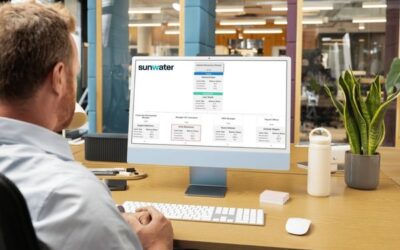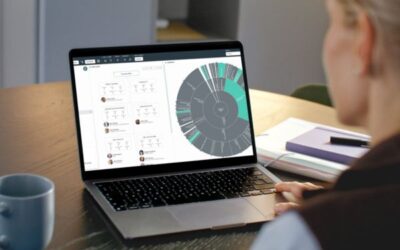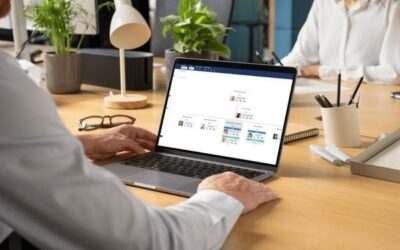What is a HR dashboard & why is it important?
Simply put, a HR dashboard is a data visualisation that consolidates essential workforce information into a user-friendly interface. It offers a comprehensive snapshot of key performance indicators (KPIs) related to your employees, spanning from company-wide metrics down to individual performance insights.
The KPIs or metrics included in a HR dashboard can vary based on the organisation’s goals. However, a typical HR dashboard may include:
- Employee demographics: Provides an overview of the workforce composition, including age distribution, gender diversity and tenure.
- Turnover metrics: Tracks employee turnover rates, reasons for departure and retention efforts to identify trends and address retention challenges.
- Performance metrics: Measures employee performance against predefined goals and objectives, including key performance indicators (KPIs) and performance ratings.
- Recruitment metrics: Analyses recruitment efforts, including time-to-fill, cost-per-hire and source effectiveness, to optimise recruitment strategies and attract top talent.
- Employee leave management: Includes tracking and managing various types of employee leave such as vacation, sick leave and other time-off requests.
In order for a HR dashboard to have a real impact on your organisation, you must make sure that it can provide accurate visibility into the make-up and efficiency of your workforce. By offering a holistic view of critical HR metrics, you will enable your leaders to make more data-driven decisions that drive organisational success.
HR dashboard reporting example
This example is a best practice HR dashboard report in org.manager – a solution that allows you to visualise all of your important HR metrics in a single (real-time) snapshot as shown below:
Tip: This view can be completely customised based on your business requirements; therefore you can display any data point that you store internally (from almost any source). Watch our on-demand webinar to get some quick tips around developing a HR dashboard, key functions and how to get your data into shape to feed into your HR dashboard software.
How HR dashboard software will improve your business
Manual reporting or trying to build your own HR dashboard from scratch is not only a time-consuming process but can be prone to human error. It’s also not the most scalable option, as it will become a difficult task to maintain as your business grows. That’s why investing in HR dashboard software early on can help mitigate these issues.
When it comes to creating a best practice HR dashboard, make sure you’re following these 3 rules:
- Be specific – Does your dashboard answer particular questions that management would ask? You’ll need to determine what are the most important (and most asked) questions relating to your workforce that need to be answered, so you can build your dashboard according to that. Remember to stick to the relevant details and filter out what’s irrelevant.
- Keep your information up to date – You can’t make good decisions off old data. Businesses move too fast for historical information to be an accurate snapshot of the current situation. Ensure that your dashboard is pulling data from your source of truth on a regular basis (usually daily), so you can be sure that you’re basing your decisions on accurate information.
- Ensure accessibility and interactivity – Make your dashboard easily accessible across the organisation. Provide interactive features such as filters, drill-down capabilities and customisable views to allow employees to explore the data and gain deeper insights. You can include user-based restrictions to ensure not everyone can access sensitive HR information.
Luckily org.manager can take care of all of this for you! Here’s five key ways that HR dashboard software can enhance your business operations:
Enhanced decision-making: By providing real-time access to critical HR metrics, such as turnover rates, engagement levels and performance trends, HR dashboards enable leaders to make informed decisions that align with organisational goals.
Increased efficiency: By streamlining admin tasks, automating reporting and centralising workforce data, HR dashboard software will help you save time and resources, so you can focus on strategic initiatives that drive business growth.
Strategic planning: By gaining insights into workforce demographics, skills gaps and succession planning, HR leaders will be better equipped to develop strategic workforce plans that better support long-term growth and sustainability.
Continuous improvement: By monitoring KPIs and performance metrics in real-time, HR dashboards facilitate a culture of continuous improvement, enabling organisations to adapt and evolve in response to changing business needs.
By using dedicated software, you can share your real-time HR dashboard with anyone in your organisation. org.manager is Australian hosted and browser based, making it easy to access and share on any device.
Final thoughts
In today’s fast-paced business environment, leveraging data-driven insights is essential for staying competitive. HR dashboards serve as a cornerstone of modern workforce management, offering a powerful platform for organisations to optimise their HR strategies and drive sustainable growth.
Navigo has 20+ years’ experience implementing successful workforce solutions across all industries in Australia. Book a demo today to discover how our portfolio of interactive HR reports will elevate the way you work.



